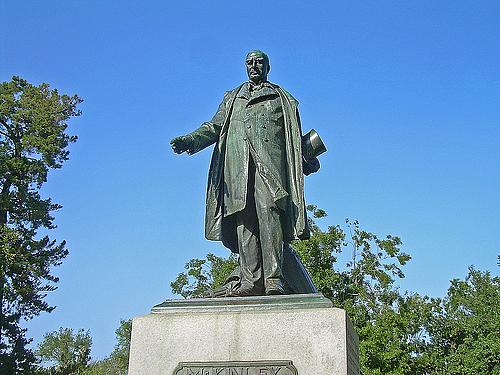A Public Death: Presidential Scholar Puts Death Certificates On a Pedestal

William McKinley, twenty-fifth president of the United States, memorialized in St. James Park, San Jose, California.
Dr. Lawrence K. Altman may know more about the health of the nation’s presidents – and a few other political leaders – than anyone else.
The medical doctor and medical writer has been writing about the maladies that plague presidents and presidential candidates since the 1970s. Now Altman, a senior scholar in United States Studies at the Wilson Center in New York and a Clinical Professor of Medicine at New York University, has done an incredible public service by elevating the discussion around death certificates.
In a recent column for the New York Times, Altman makes plain why death certificates are so vitally important:
The death certificate is a document that has myriad benefits for the living: establishing a legal basis for life insurance and estate settlements; providing critical information to survivors and descendants in an era of burgeoning advances in genetics; advancing knowledge about diseases, accidents and other causes of death; and much else.
The column should be laminated and put up in hospitals and coroner’s offices worldwide. Not only does it nicely articulate the reason death certificates are so important, it also enumerates many of the clumsy and careless ways this important resource is contaminated.
To make his case, Altman focused on two recent studies in the journal Preventing Chronic Disease. One study gathered evidence from surveys about physicians’ attitudes toward filling out accurate death certificates. The second study focused on the reliability of death certificates once they had been filled out. I’ll discuss the first in this post and the next in a later post.
The survey study started in May and June 2010. The researchers attempted to gathered anonymous responses via the Internet from participants in all internal medicine, emergency medicine, and general surgery residency programs in New York City.
The researchers, led by Barbara A. Wexelman a resident at St. Luke’s Hospital Roosevelt Center, were able to get 521 people to respond – a pretty good sample. What did they find?
About half of all the resident doctors said that they had flat out reported an incorrect cause of death. Knowing that, it’s perhaps not surprising that two-thirds of them said that the current system fails to accurately document causes of death.
The researchers wrote:
We defined high-volume respondents as those who completed 11 or more death certificates in the last 3 years…. Only 33.3% of all respondents and 22.7% of high-volume residents believed that cause-of-death reporting is accurate. Of all respondents, 48.6% had knowingly reported an inaccurate cause of death; 58.4% of high-volume residents had done so. Of respondents who indicated they reported an inaccurate cause, 76.8% said the system would not accept the correct cause, 40.5% said admitting office personnel instructed them to “put something else,” and 30.7% said the medical examiner instructed them to do so; 64.6% cited cardiovascular disease as the most frequent diagnosis inaccurately reported.
Why would a medical resident, someone devoted to improving human health, be so callous about the documentation of a person’s final health outcome? Altman wrote:
The reasons varied. Some doctors said they never learned the proper procedures or were too busy to fill out the documents correctly. Because of restrictions in duty hours, many resident doctors had to enter a cause even though they did not know the patients — they just assumed care through transfers at the end of work shifts. Some said data codes forced them to enter diagnoses that did not match their medical judgments: The system rejected causes like sepsis from infection or acute respiratory distress syndrome, and hospital administrators instructed the doctors to certify another cause of death.
Altman points to another key finding of the study, one that has an actual solution. Most residents said that they were never formally trained in how to fill out a death certificate. Not in medical school. Not in residency, either.
Now, here’s the good news. The researchers did the study in the spring of 2010. Just prior to that, in 2009, the New York City Department of Health and Mental Hygiene started a new training program in eight hospitals to improve cause of death reporting. One can only hope that it gets expanded and becomes a model. In public health, New York tends to be a trendsetter.
As a cool aside, Altman’s academic credentials may have come into play in how the Times illustrated his piece. They created a great slideshow of death certificates from politicians, athletes and other notables.
Image by roarofthefour via Flickr

